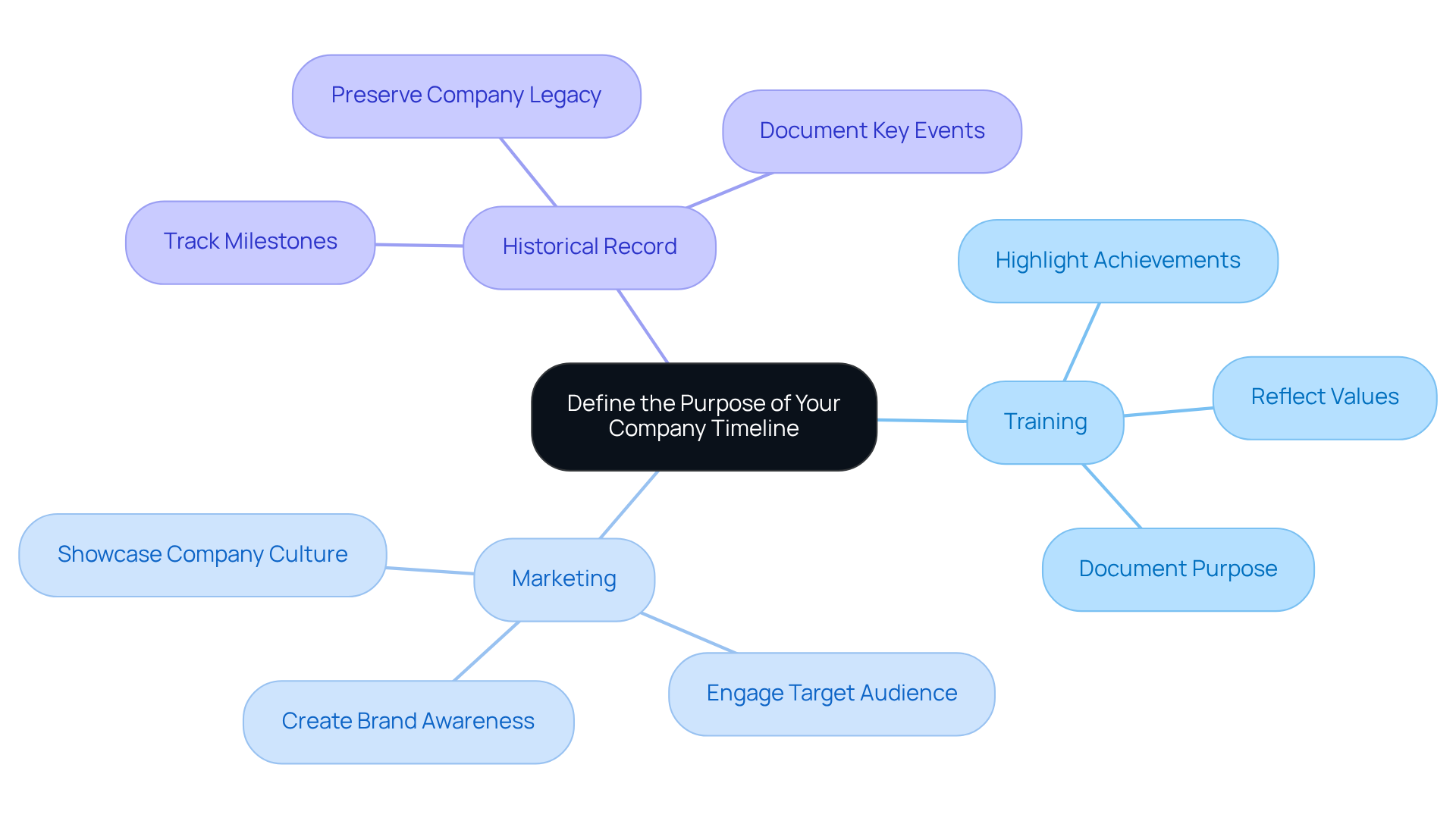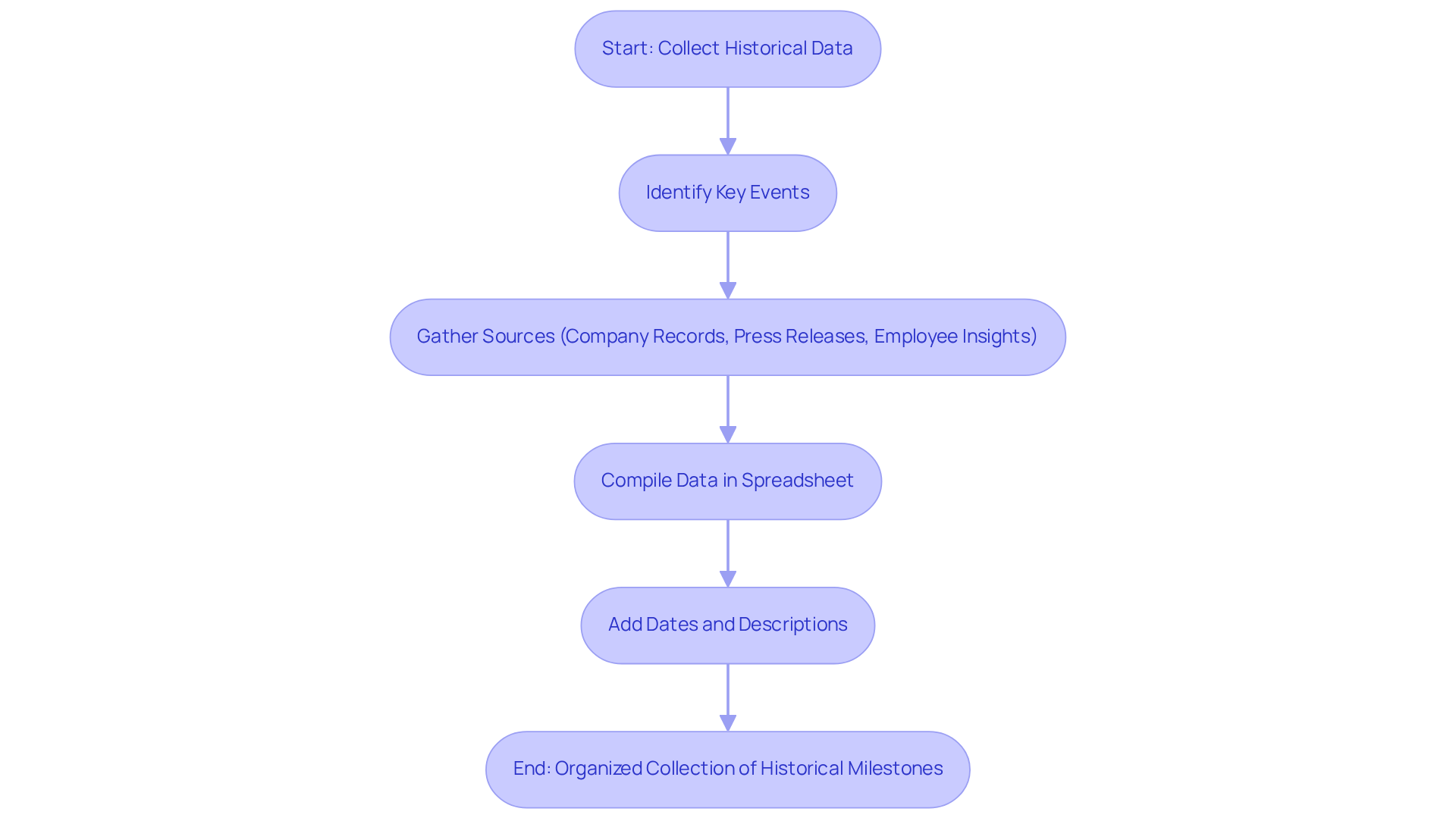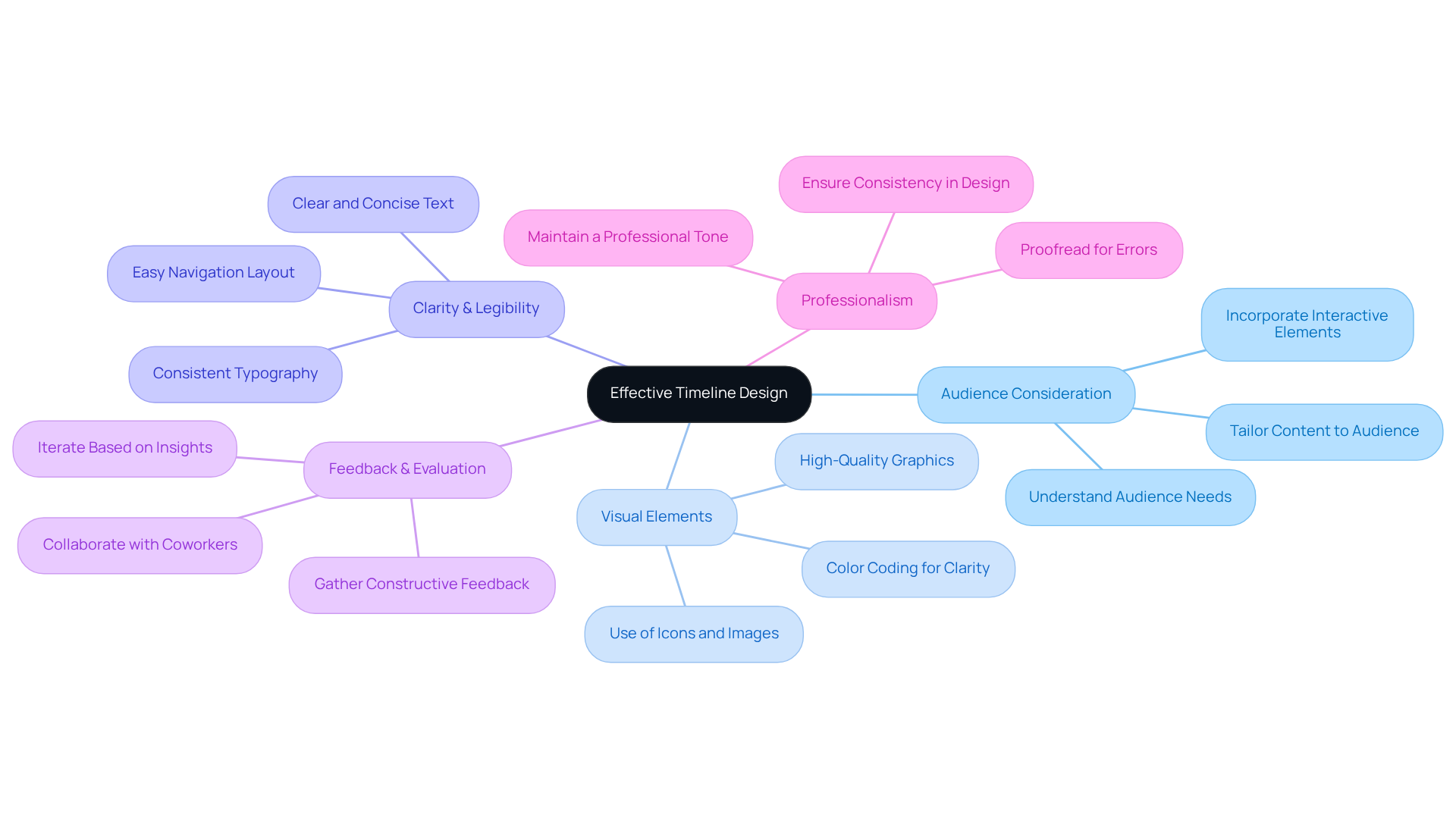
Scaling Businesses with Documentation
|
October 16, 2025
|
4 Steps to Create a Timeline Company History Effectively
Overview
You might be wondering how to create a company history timeline that truly resonates with your audience. Well, it all starts with four essential steps!
- Define the purpose of your timeline—what story do you want to tell?
- Gather key historical data that highlights your company's journey.
- Organize the information chronologically.
- Design it for presentation!
Each of these steps is crucial for clarity and engagement.
Now, let’s dive into why these steps matter. Clarity is key, especially when you’re presenting to different audiences like employees or stakeholders. You want them to not just see the information, but feel connected to it. With practical advice on tools and methods, you’ll enhance the effectiveness of your timeline, making it a valuable resource for everyone involved. So, are you ready to embark on this journey of documenting your company’s rich history?
Key Highlights:
- Define the purpose of the company timeline to guide its development, whether for training, marketing, or historical documentation.
- Documenting the timeline’s purpose enhances clarity and effectiveness, improving employee onboarding experiences.
- Collect key historical data, including founding dates and major milestones, from various sources such as company records and employee interviews.
- Organise historical information chronologically to create a clear and coherent timeline, utilising tools like Tiki-Toki or Preceden for visual representation.
- Incorporate visual elements, colour coding, and clear layouts in the timeline design to engage viewers and enhance understanding.
- Proofreading and evaluating the timeline with colleagues is crucial to ensure professionalism and clarity before wider dissemination.
Introduction
Creating a company timeline isn’t just about putting dates on a page; it’s a fantastic way to shape your organizational culture and boost employee engagement. You might be wondering, how can a timeline do all that? Well, by clearly defining the purpose behind it, businesses can highlight their milestones, celebrate achievements, and build a sense of belonging among team members. But here’s the catch: turning a bunch of dates and events into a story that resonates with your audience can be tricky. So, how can organizations make sure their timelines not only inform but also inspire?
In this guide, we’ll explore four essential steps to craft an impactful company history timeline that truly captures the essence of your organization’s journey. Now, let’s dive into it!
Define the Purpose of Your Company Timeline
To effectively develop your organization's schedule, you might be wondering where to start. First, define its purpose. Will it be for internal training, marketing, or maybe even a historical record? A clearly articulated objective not only makes it easier to choose relevant events and achievements but also boosts the overall efficiency of the schedule. For example, if the schedule is meant for integrating new staff, it should highlight significant accomplishments and cultural landmarks that reflect your organization's values.
Research shows that employees who have positive experiences during their first 90 days at a company are much more likely to stick around for the long haul. So, it's super important to document this purpose clearly! Plus, over 80% of employees who feel clarity during onboarding end up holding their organization in high regard. By clearly documenting this purpose, you’ll create a guiding framework for the next steps in the timeline company history creation process, ensuring it resonates with your intended audience and meets its objectives. Now, let’s dive into how you can make this happen!

Collect Key Historical Data and Milestones
So, you’re ready to dive in and compile a list of key historical information and significant events? Great! This can include everything from founding dates to product launches, major partnerships, and even those big leadership changes. To gather this info, think about tapping into various sources like company records, press releases, and even chatting with long-standing employees who have seen it all.
Now, once you’ve got that treasure trove of information, create a spreadsheet or document to neatly arrange these achievements. Make sure to note the dates and add a brief description of each occurrence. Trust me, this organized collection will become the backbone of your schedule, making it easier to see the journey your company has taken over the years!

Organize Information Chronologically
You might be wondering how to efficiently develop a company schedule. Well, it all starts with organizing your timeline company history by arranging your milestones in sequential order—beginning with the earliest and moving to the latest. You can keep it simple with a list format or spice things up with specialized timeline software for that extra visual clarity. Each entry should have the date and a brief description, making it easy for everyone to grasp the order of events and how they relate to each other.
Research shows that getting organized can really boost project tracking and communication within teams. So, why not try some best practices like color coding or using icons to differentiate between types of events? For example, a tech company might use blue for product launches and green for major partnerships. It’s a fun way to keep things clear! As industry experts say, 'Have nothing in your house that you do not know to be useful or believe to be beautiful.' This applies to schedules too—organized ones can enhance clarity and efficiency in your organization.
Now, let’s dive into some tools that can help! Tiki-Toki or Preceden are great for generating visually appealing chronological representations that clarify the timeline company history of your projects. Plus, using SowFlow's instant documentation solution can simplify standardizing your schedule. This means updates are a breeze, and your team has immediate access to the most relevant information, boosting overall productivity. So, are you ready to take your scheduling game to the next level?

Design and Present Your Timeline Effectively
You might be wondering how to effectively design and present your schedule. Well, choosing a format that resonates with your audience is key! Think about using digital tools like Canva for interactive presentations, or maybe opt for printed versions if you’re going for physical displays. And don’t forget to incorporate visuals—images, icons, and color coding can really amp up engagement and make your schedule memorable.
It’s also super important to ensure that your text is clear and legible, and that the layout is easy to navigate. Have you ever evaluated your schedule with coworkers? It can offer valuable insights on its clarity and effectiveness, helping you make any necessary tweaks before you share it more widely. Remember, a well-crafted schedule does more than just convey information; it engages viewers, making your presentation more impactful.
As Alina Wheeler puts it, "Design is intelligence made visible," which really highlights how thoughtful design plays a crucial role in presentations. Plus, did you know that 70% of professionals believe presentation skills are vital for career progression? That’s why taking the time to create captivating schedules is so important for operations managers.
And let’s not overlook proofreading! It’s essential for maintaining professionalism that your timeline company history is free from errors and effectively communicates your message. So, what are you waiting for? Let’s dive into creating that schedule!

Conclusion
Creating a timeline of your company's history isn't just about jotting down dates and events; it's a strategic move that can really boost your organizational culture and employee engagement. You might be wondering how this works. By clearly defining the purpose of your timeline, gathering key historical data, organizing that info chronologically, and presenting it in a visually appealing way, you can weave a narrative that resonates with both employees and stakeholders.
So, what are the steps to make this happen?
- Define the purpose to guide your content.
- Collect those important historical data points and milestones to paint a comprehensive picture of your company’s journey.
- Organize everything chronologically for clarity.
- Design and present your timeline in a way that catches the eye.
Each of these steps is vital for ensuring that your timeline serves its intended function—whether for internal training, marketing, or historical documentation.
In the end, a well-crafted company timeline is more than just a historical record; it’s a storytelling tool that can create a deeper connection with your organization’s mission and values. By dedicating time and effort to this process, you’re not just honoring your past—you’re also paving the way for future growth and innovation. So, why not seize the chance to create a compelling timeline that showcases your organization’s unique journey? You’ll likely find that it strengthens your company culture and enhances employee engagement in ways you never expected.
Frequently Asked Questions
Why is it important to define the purpose of a company timeline?
Defining the purpose of a company timeline is crucial as it helps in selecting relevant events and achievements, boosts overall efficiency, and creates a guiding framework for the timeline creation process.
What are some potential purposes for a company timeline?
A company timeline can serve various purposes, including internal training, marketing, or serving as a historical record.
How does a well-defined purpose impact employee onboarding?
A clearly articulated purpose during onboarding can enhance new employees' experiences, leading to higher retention rates and positive perceptions of the organization.
What is the significance of documenting the timeline's purpose?
Documenting the timeline's purpose ensures that the timeline resonates with its intended audience and meets specific objectives, making it more effective.
👍
What others are liking
5 Steps to outline your ideal documentation structure
5 MINS READ
Where to start the your journey of mapping out your ideal documentation structure, aligning it with the very heartbeat of your organization?
Defining a winning level of detail in your process
3 MINS READ
What is too much detail, and what is too little? This article described in that winning level detail about what detail is enough.





